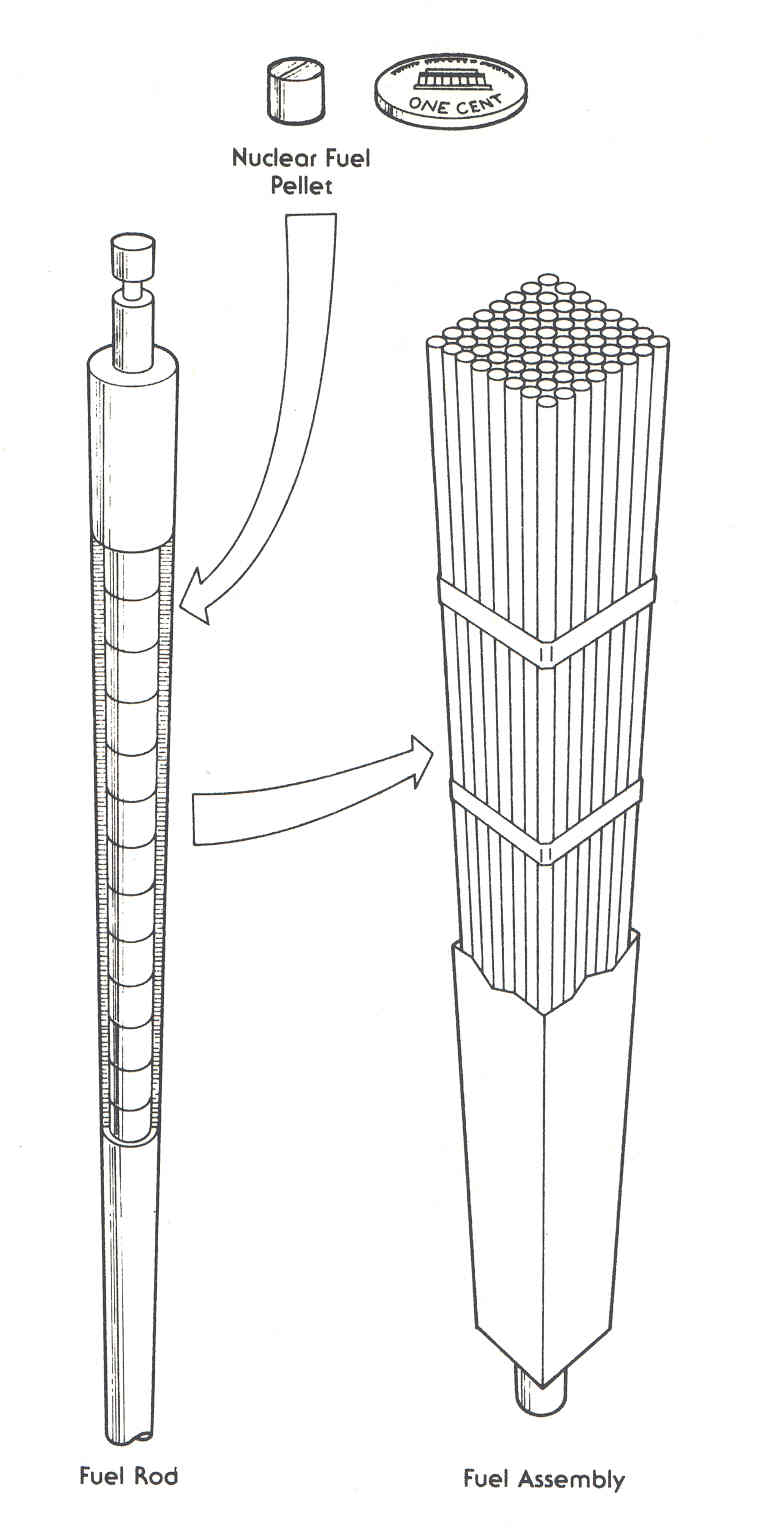Nuclear Energy Activist Toolkit #22
Lots of people have lots of reasons for preventing damage to nuclear fuel inside the core of nuclear power reactors. But what is done to help meet this goal?
The nuclear fuel for boiling water reactors (BWRs) consists of uranium pellets loaded inside hollow metal tubes called fuel rods. Metal caps are welded on the ends of fully loaded fuel rods to seal them. Dozens of fuel rods are put together to form a fuel assembly. A fuel assembly is about six inches wide, six inches deep, and over 12 feet long.
The reactor cores in U.S. BWRs consist of 500 to 800 fuel assemblies. Workers move individual fuel assemblies into and out of the reactor cores at the end of telescoping booms. The picture shows an irradiated fuel assembly glowing blue as it is transported above the reactor core of one of the BWRs at the Browns Ferry nuclear plant in Alabama. (Unlike a refrigerator, this light doesn’t go out when the reactor vessel’s lid is closed.)
When a BWR operates, three limits protect nuclear fuel from damage.
The fuel pellets as well as the metal fuel rods encasing them expand and contract as power changes cause local temperatures to change. The pellets and rods do not expand equally. The maximum power output from a fuel rod is limited to protect the fuel rod from being stretched to the breaking point by expanding pellets. This limit guards against fuel damage during normal operation. Two other limits guard against damage during postulated transients and accidents.
As implied by its name, water boils as it flows through the core of a boiling water reactor. Heat produced by atoms splitting within the fuel pellets is conducted through the pellets and the metal fuel rods to warm and boil water. In what is called nucleate boiling, the heat causes steam bubbles to form in the water wetting the outer surfaces of the metal fuel rods. These bubbles get swept away by the flow to join with lots of other bubbles in the steam carried off to the turbine. When too much heat is produced, the bubbles forming on the fuel rod surfaces can link up to become a solid blanket in what is called film boiling. Instead of allowing water to touch the fuel rod surfaces and carry away heat passing through the metal walls, the steam blanket essentially insulates the fuel rods keeping much of the heat inside and causing the fuel pellets to overheat. The maximum power output from a fuel assembly is limited to protect against fuel damage caused by film boiling.
During an accident, a ruptured pipe can quickly drain cooling water from the reactor vessel containing the reactor core. Instead of flowing past fuel rods to carry away heat, water can jet out the broken ends of the ruptured pipe. BWRs have an array of emergency core cooling pumps that will automatically start up and supply makeup water to the reactor vessel to restore the water level and sustain it despite inventory continuing to pour from the broken pipe ends. But these pumps are normally in standby mode and it takes them a few seconds to get off the bench and into the game. To guard against overheating damage during the seconds that fuel rods are left to fend for themselves during an accident, the maximum power output from a six-inch segment of a fuel assembly is limited during normal operation. (Recall that fuel assemblies are roughly six inches deep by six inches wide, so this six-inch segmentation essentially divides the core into six-inch cubes. The amount of decay heat generated by radioactive byproducts from fissioning atoms within fuel pellets is directly related to the initial power output. The third limit guards against the decay heat causing overheating damage to the nuclear fuel before the emergency core cooling systems can reflood the reactor vessel and resume carrying away the heat.
The maximum power produced by fuel rods, fuel assemblies, and six-inch segments of fuel assemblies are limited to protect against fuel damage during normal operation, transients, and accidents respectively.
Bottom Line
Fuel pellets and fuel rods are some of the barriers protecting workers and the public from dangerous radioactive materials. When intact, solid radioactive particles and gases stay in place rather than getting places where they can harm people. Three limits on nuclear fuel performance at BWRs attempt to keep the fuel rods intact during normal operation as well as during transients and accidents. (Pressurized water reactors employ comparable tactics for the same purpose.)
The three damaged BWR cores at Fukushima Daiichi demonstrate that these three limits provide protection rather than guarantees. All the limits were met on March 11, 2011, when the earthquake occurred. But the limit on maximum six-inch segment powers was predicated on the emergency core cooling systems restoring heat removal within certain timeframes. When those deadlines passed, so too did the chances of preventing core meltdowns.
The UCS Nuclear Energy Activist Toolkit (NEAT) is a series of post intended to help citizens understand nuclear technology and the Nuclear Regulatory Commission’s processes for overseeing nuclear plant safety.


